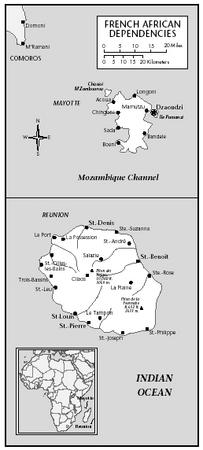French African Dependencies - RÉunion
Réunion, about 675 km (420 mi) E of Madagascar in the Indian Ocean, is the largest island in the Mascarene Archipelago. Réunion lies between 20° 52′ and 21° 22′ S and between 55° 13′ and 55° 50′ E , is 55 km (34 mi) long and 53 km (33 mi) wide, and has a coastline of 207 km (129 mi). It has an area of 2,510 sq km (969 sq mi).
Volcanic in origin, Réunion is mountainous, with 10 peaks— one of them, Piton de la Fournaise, still an active volcano—rising

above 2,600 km (8,500 ft). The highest, Piton des Neiges, has an altitude of 3,069 m (10,066 ft). Rosewood, ebony, ironwood, and other tropical hardwoods are represented in the forests near the coast. Torrential rivers are numerous. The mean annual temperature is 23° C (73° F ) at sea level, but the climate, generally tropical, varies with orientation and altitude. The east coast receives almost daily precipitation, totaling some 350 cm (140 in) annually, but on the north coast, annual rainfall is only about half that. Cyclones, which threaten from December to April, have devastated Réunion several times. The tropical cyclone monitoring center at Saint-Denis serves the entire Indian Ocean area. Sea fauna is rich and varied.
The population was estimated to be 743,981 in mid-2002. One-fourth of the islanders are of French origin, including those in the military; Réunion is the headquarters for French military forces in the Indian Ocean area. As of 1995, about 86% of the population was Roman Catholic, with the remainder practicing Hinduism, Islam, or Buddhism.
There are about 2,724 km (1,703 mi) of roads, about 1,300 km (810 mi) of which were paved as of 2002. Only the sugar plantations have functioning rail service. Pointe des Galets is the chief port, Saint-Pierre the main fishing port. Air France maintains a service from Gillot-Sud Airfield, near Saint-Denis, to Madagascar, and there are regular steamer services.
Réunion had 268,500 main telephone lines and 197,000 mobile cellular telephones in service in 2000. As of 2001, there were 35 television stations, 2 AM, and 55 FM radio stations. The newspapers Journal de l'Île de la Réunion, Quotidien de la Réunion, and Témoignages are published daily.
At the time of its discovery on 9 February 1513 by the Portuguese explorer Pedro de Mascarenhas, Réunion was uninhabited. A few French colonists came in the 16th century to Bourbon Island, as it was then known. It was settled by the French as a penal colony in the early 17th century, and in 1665, it became an outpost of the French East India Company. Coffee, and after 1800 sugarcane, helped make the colony relatively prosperous. French immigration continued from the 17th to the 19th century, supplemented by influxes of Negroes, Malays, Indochinese, Chinese, and Malabar Indians. The island received its present name in 1793. With the mid-19th century came a decline in Réunion's prosperity: slavery was abolished in 1848, and the opening of the Suez Canal in 1869 cost the island its importance as a stopover on the East Indies route.
An overseas department of France since 1946, and elevated to regional status in 1973, Réunion is represented in the French parliament by five deputies and three senators. Local administration is patterned on that of metropolitan France. There are a regional council of 45 elected members and a general council of 49. Elections were scheduled for 2004.
The GDP was estimated at US $3.4 billion in 1998, or US $4,800 per capita. Sugarcane, vanilla, tobacco, tropical fruit, vegetables, and corn are the primary agricultural products. Sugarcane is an important crop, accounting for up to 63% of exports. In addition to sugar, rum and molasses, perfume essences, and lobster are among the exports. Manufactured goods, food, beverages, tobacco, machinery and transportation equipment, raw materials, and petroleum products are the main imports.
The monetary units are the euro and the French franc. Approximately three-quarters of exports and two-thirds of imports are traded with France. Exports totaled $214 million in 1997; imports totaled $2.5 billion.
The infant mortality rate was 8.31 deaths per 1,000 live births in 2002, up from 6.9 per 1,000 live births in 1999, but still an improvement over the rate 13 per 1,000 live births in the mid-1980s. The Université de la Réunion is in Saint-Denis.
In 1968, certain islands that had previously been administered from Madagascar, and later by the French Southern and Antarctic Territories, were placed under the direct administration of the commissioner residing in Saint-Denis. Europa Island (22° 21′ S and 40° 21′ E ), in the Mozambique Channel about 340 km (210 mi) west of Madagascar, is heavily wooded and has a meteorological station and airstrip. Bassas da India (21° 27′ S and 39° 45′ E ), in the Mozambique Channel, is a volcanic rock 2.4 m (8 ft) high, surrounded by reefs, which disappears under the waves at high tide. Juan de Nova (also known as Saint-Christophe, at 17° 3′ S and 42° 43′ E ), also in the Mozambique Channel, about 145 km (90 mi) west of Madagascar, is exploited for its guano and other fertilizers. The Glorioso Islands (Îles Glorieuses), in the Indian Ocean 213 km (132 mi) northwest of Madagascar, at about 11° 34′ S and 47° 17′ E , consist of Grande Glorieuse, the Île du Lyse, and three tiny islets, the Roches Vertes; principal products are coconuts, corn, turtles, and guano. Tromelin Island (15° 53′ S and 54° 31′ E ) has an important meteorological station.
Comment about this article, ask questions, or add new information about this topic: